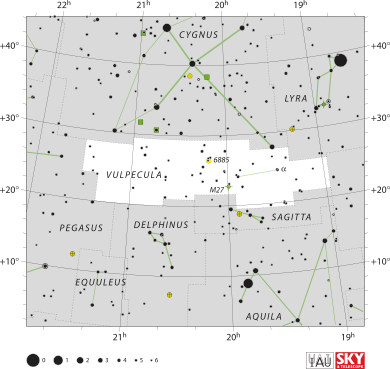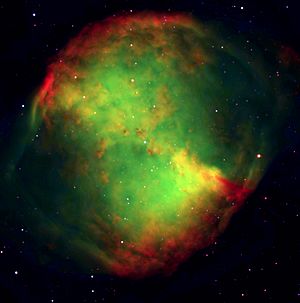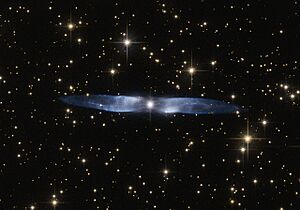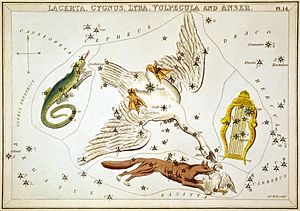Vulpecula facts for kids
| Constellation | |

|
|
| Abbreviation | Vul |
|---|---|
| Genitive | Vulpeculae |
| Pronunciation | genitive |
| Symbolism | the Fox |
| Right ascension | 20h |
| Declination | +25° |
| Quadrant | NQ4 |
| Area | 268 sq. deg. (55th) |
| Main stars | 5, 20 |
| Bayer/Flamsteed stars |
33 |
| Stars with planets | 5 |
| Stars brighter than 3.00m | 0 |
| Stars within 10.00 pc (32.62 ly) | 0 |
| Brightest star | α Vul (Anser) (4.44m) |
| Messier objects | 1 |
| Bordering constellations |
Cygnus Lyra Hercules Sagitta Delphinus Pegasus |
| Visible at latitudes between +90° and −55°. Best visible at 21:00 (9 p.m.) during the month of September. |
|
Vulpecula is a faint constellation you can find in the northern sky. Its name means "little fox" in Latin. Even though it's officially "little fox," most people just call it "the Fox." Astronomers first identified this constellation in the 1600s. It sits right in the middle of the Summer Triangle. The Summer Triangle is a cool pattern of three bright stars: Deneb, Vega, and Altair.
Contents
Exploring the Fox Constellation
Stars of Vulpecula
Vulpecula doesn't have any super bright stars. The brightest one is Alpha Vulpeculae, also called Anser. It's a red giant star about 291 light-years away. You can even see it as two stars with binoculars! The name Anser refers to a goose that the little fox is imagined to hold.
23 Vulpeculae is the second brightest star in this constellation.
Amazing Discoveries: Pulsars
In 1967, something amazing was found in Vulpecula. Scientists discovered the very first pulsar here. A pulsar is a super fast-spinning neutron star. It sends out beams of radio waves, like a lighthouse. When these beams sweep past Earth, we detect them as regular "pulses." This first pulsar was named PSR B1919+21.
Fifteen years later, another record was set in Vulpecula. The first millisecond pulsar was found. This type of pulsar spins incredibly fast, hundreds of times per second! It was named PSR B1937+21.
Exoplanets and Water
Vulpecula is also home to HD 189733 b. This is a planet outside our solar system, called an extrasolar planet. Scientists studied it with the Spitzer Space Telescope. In 2007, they found strong evidence of water vapor in its atmosphere!
Even though HD 189733b is too hot for life (over 1,000°C), finding water there is a big deal. It makes scientists hopeful that water, which is key for life, could be found on other planets that are more like Earth.
Fast Radio Bursts
In 2020, a special object in Vulpecula, SGR 1935+2154, made headlines. It's a soft gamma repeater, which means it sends out powerful bursts of gamma rays. This time, it also shot out a fast radio burst. This was the first time such a burst was seen coming from within our own galaxy, the Milky Way!
Deep-Sky Wonders
Vulpecula is full of interesting objects far beyond our solar system.
The Dumbbell Nebula
One of the most famous is the Dumbbell Nebula (M27). It's a large, bright planetary nebula. A planetary nebula is a cloud of gas and dust formed when a star like our Sun dies. French astronomer Charles Messier discovered it in 1764. It was the very first object of its kind ever found!
You can see it with good binoculars in a dark sky. It looks like a dim, glowing disk. Through a telescope, you can see its unique double-lobed shape, which looks a bit like an hourglass. This nebula is about 9,800 years old.
The Coathanger
Another cool sight is Brocchi's Cluster (Collinder 399). It's an asterism, which means it's a pattern of stars that looks like something. People call it "the Coathanger" because that's exactly what it looks like through binoculars or a small telescope!
Distant Galaxies and Structures
NGC 7052 is an elliptical galaxy in Vulpecula. It's about 214 million light-years from Earth. This galaxy has a dusty disk in its center. It also has a supermassive black hole at its heart. Scientists think the dusty disk is what's left of a smaller galaxy that crashed into NGC 7052. This galaxy also shoots out powerful astrophysical jets and has strong radio emissions.
The eastern part of Vulpecula holds something truly massive: the Hercules–Corona Borealis Great Wall. This is a huge group of galaxies stretched out like a long filament. It's about 3,000 megaparsecs long, making it the largest known structure in the entire universe!
Star-Forming Regions
Vulpecula also contains a special area called the Vulpecula OB-association (or Vul OB1). This is a group of nearly 100 very young, hot, and bright stars. It also has over 800 "young stellar objects," which are stars that are still forming. This region is about 2,300 parsecs away. It's a busy place where new stars are being born!
History of Vulpecula
The constellation Vulpecula was created in the late 1600s by an astronomer named Johannes Hevelius. He originally called it Vulpecula cum ansere, which means "the little fox with the goose." Sometimes it was also called Vulpecula et Anser ("the little fox and the goose").
Hevelius drew the constellation as a fox holding a goose in its mouth. At first, he didn't see the fox and goose as separate constellations. Later, some stars were split into a separate "Anser" (goose) constellation and "Vulpecula" (fox). But today, they are back together under the name of the fox. However, the goose is still remembered! The brightest star in Vulpecula, Alpha Vulpeculae, is still called Anser.
See also
 In Spanish: Vulpecula para niños
In Spanish: Vulpecula para niños





